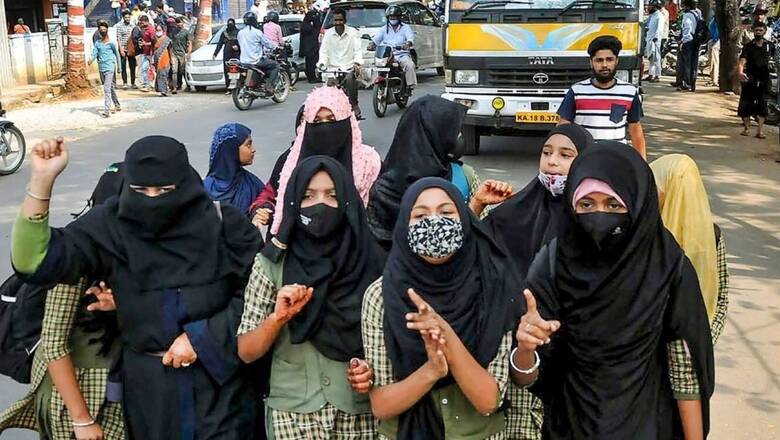
views
Last month, the Karnataka government allowed Muslim women candidates to wear the hijab for the National Eligibility cum Entrance Exam (NEET) in the state. This decision was strongly protested by some Hindu groups, and labelled by the Opposition BJP as an act of ‘minority appeasement’. The hijab controversy in general dates back to January 2022 when six girls wearing the hijab were prevented from entering the Government PU College in Udupi. The college insisted that educational institutions have the right to prescribe a uniform for students. Its decision was strongly supported by the BJP state government then in power, and pro-Hindu groups.
The matter was finally referred to the Karnataka High Court (HC), which upheld the ban. An appeal was filed against this judgement in the Supreme Court (SC). It was heard by a two-judge bench in October last year. The SC bench gave a split verdict. Justice Hemant Gupta, upheld the Karnataka HC order, banning religious dresses, including hijab, for all educational institutions. In a radically divergent opinion, Justice Sudhanshu Dhulia held that wearing the hijab was a choice of Muslim women, ‘nothing more and nothing else’. A three-judge bench will now hear this appeal, and the final verdict by the apex court is pending.
It is in this context that the recent decision by the current Karnataka government to allow hijab for the NEET exam must be seen. In the gap between the anti-hijab protests of January 2022 and the decision regarding NEET taken now, governments have changed in Karnataka. The BJP lost the Assembly elections, and the Congress came to power. It is not surprising, therefore, that the BJP, now in Opposition, would oppose the decision seeing it as some form of legitimising hijab where education is concerned.
Karnataka’s Higher Education Minister, MC Sudhakar, has argued that the dress guidelines of NEET allow for the wearing of hijab. In my view, he has a point. The NEET dress code for female candidates says: ‘Similar to the dress code of NEET for male candidates, female candidates are also advised to wear half sleeve T-shirts/shirts/kurta. The guidelines prohibit long sleeves and fancy-sleeved clothing, metallic and non-metallic jewellery, closed shoes, and advocate simple clothing without elaborate embroidery, buttons, frills, etc, and open sandals or slippers.
It then expressly makes the following exception: ‘Candidates who would not be able to follow the dress code for NEET 2023 due to religious beliefs have to mention the same while filling the application form for NEET 2023. Such candidates have to select the “Customary Dress” option while filling out the NEET application form. Those opting to wear the customary dress have to report at least an hour early for proper frisking and security procedures. In such cases, candidates need to reach the exam centre by 12.30 pm so that there is sufficient time for proper security checks without any inconvenience to the candidate while maintaining the sanctity of the exam’.
A simple reading of this would leave little doubt that female candidates are allowed to wear ‘customary’ dress ‘due to religious beliefs’, with the proviso that they state this option while applying for the exam, and report for it at least an hour earlier to ensure frisking and security procedures.
If this is the case, what is the controversy about, and why the protests? The answer to this is that hijab has become a larger issue of confrontation between radical pro-Hindu groups and equally radical Muslim organizations. For those who oppose it, hijab is a sign of Muslim women’s subordination by misogynist Muslim men, and like the abolition of triple talaq—which was, indeed, a reform measure—should be done away with. They argue also that no ‘exceptions’ should be made to uniform dress codes, merely to suit a custom of a minority, especially when, according to them, it has no scriptural sanction in Islam.
Those who support hijab, argue that it is the right of a woman to decide what she wants to wear, and this freedom of choice is sacrosanct, and protected by the Constitution.
My own view is that, while Muslim women have the right of choice of what to wear, this freedom cannot be a reason for their perpetual sartorial enslavement in a society where men decide what is ‘right’ or ‘wrong’ custom. Do Muslim women really have the choice not to wear the hijab? Or is their ‘free’ choice the result of imposed conditioning or diktats by men? It is a fact that many Muslim nations have done away with the hijab as an act of reform. But they are Muslim-majority countries. Here we are dealing with the rights of a minority community, and stigmatising their practices as a routine matter could lead to allegations of unwarranted intervention, and acrimonious debate about what needs to change in other religious denominations, where, indeed, there is also scope for reform.
Therefore, in such matters, it is far better if the move for change comes from within the Muslim community itself, where women themselves push to do away with a ‘customary’ practice that is not in conformity with the dignity and equality that is their right. To impose change, especially by those from another religious community, could be counter-productive, and have the deleterious effect of making Muslim women, who otherwise would like to oppose such practices, even more entrenched in their resolve to hold on to it, to preserve and assert their identity against enforced homogenisation.
In the interim, it is best not to communalise this sensitive matter for political reasons, and await the verdict of the SC.
The author is a former diplomat, an author and a politician. Views expressed in the above piece are personal and solely that of the author. They do not necessarily reflect News18’s views.




















Comments
0 comment